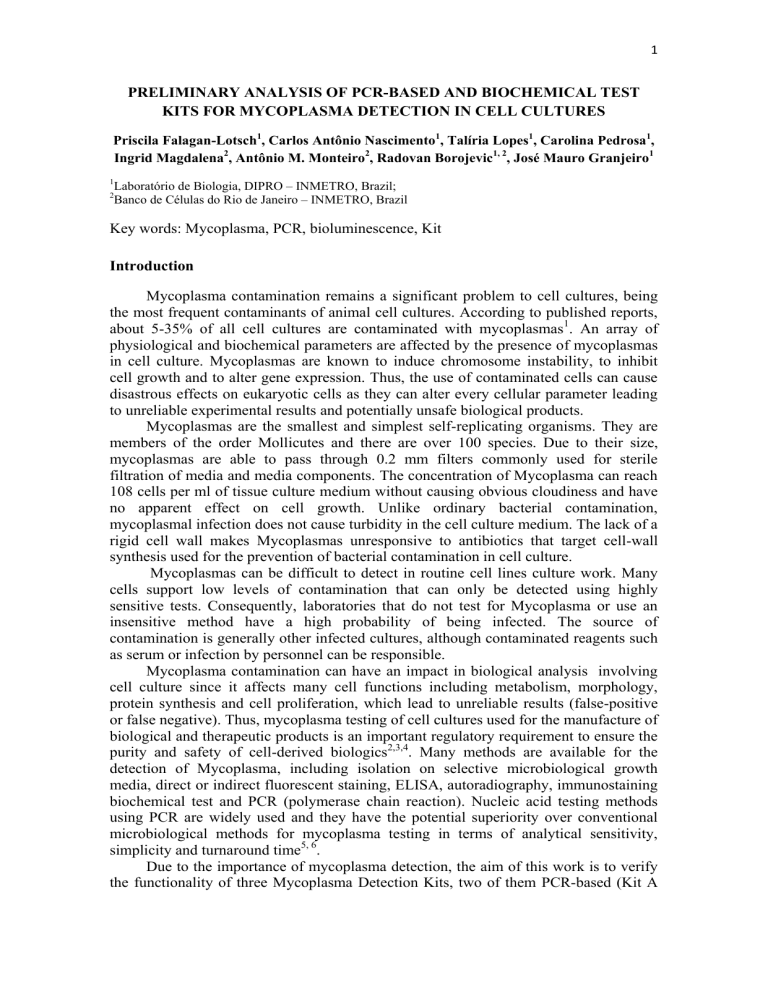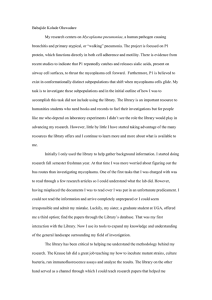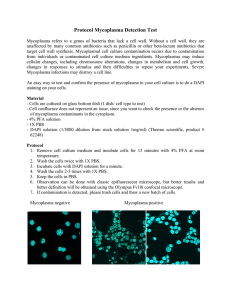PRELIMINARY ANALYSIS OF PCR-BASED AND BIOCHEMICAL TEST

1
PRELIMINARY ANALYSIS OF PCR-BASED AND BIOCHEMICAL TEST
KITS FOR MYCOPLASMA DETECTION IN CELL CULTURES
Priscila Falagan-Lotsch
1
, Carlos Antônio Nascimento
1
, Talíria Lopes
1
, Carolina Pedrosa
1
,
Ingrid Magdalena
2
, Antônio M. Monteiro
2
, Radovan Borojevic
1, 2
, José Mauro Granjeiro
1
1
Laboratório de Biologia, DIPRO – INMETRO, Brazil;
2
Banco de Células do Rio de Janeiro – INMETRO, Brazil
Key words: Mycoplasma, PCR, bioluminescence, Kit
Introduction
Mycoplasma contamination remains a significant problem to cell cultures, being the most frequent contaminants of animal cell cultures. According to published reports, about 5-35% of all cell cultures are contaminated with mycoplasmas
1
. An array of physiological and biochemical parameters are affected by the presence of mycoplasmas in cell culture. Mycoplasmas are known to induce chromosome instability, to inhibit cell growth and to alter gene expression. Thus, the use of contaminated cells can cause disastrous effects on eukaryotic cells as they can alter every cellular parameter leading to unreliable experimental results and potentially unsafe biological products.
Mycoplasmas are the smallest and simplest self-replicating organisms. They are members of the order Mollicutes and there are over 100 species. Due to their size, mycoplasmas are able to pass through 0.2 mm filters commonly used for sterile filtration of media and media components. The concentration of Mycoplasma can reach
108 cells per ml of tissue culture medium without causing obvious cloudiness and have no apparent effect on cell growth. Unlike ordinary bacterial contamination, mycoplasmal infection does not cause turbidity in the cell culture medium. The lack of a rigid cell wall makes Mycoplasmas unresponsive to antibiotics that target cell-wall synthesis used for the prevention of bacterial contamination in cell culture.
Mycoplasmas can be difficult to detect in routine cell lines culture work. Many cells support low levels of contamination that can only be detected using highly sensitive tests. Consequently, laboratories that do not test for Mycoplasma or use an insensitive method have a high probability of being infected. The source of contamination is generally other infected cultures, although contaminated reagents such as serum or infection by personnel can be responsible.
Mycoplasma contamination can have an impact in biological analysis involving cell culture since it affects many cell functions including metabolism, morphology, protein synthesis and cell proliferation, which lead to unreliable results (false-positive or false negative). Thus, mycoplasma testing of cell cultures used for the manufacture of biological and therapeutic products is an important regulatory requirement to ensure the purity and safety of cell-derived biologics
2,3,4
. Many methods are available for the detection of Mycoplasma, including isolation on selective microbiological growth media, direct or indirect fluorescent staining, ELISA, autoradiography, immunostaining biochemical test and PCR (polymerase chain reaction). Nucleic acid testing methods using PCR are widely used and they have the potential superiority over conventional microbiological methods for mycoplasma testing in terms of analytical sensitivity, simplicity and turnaround time
5, 6
.
Due to the importance of mycoplasma detection, the aim of this work is to verify the functionality of three Mycoplasma Detection Kits, two of them PCR-based (Kit A
2 and Kit B) and the third one (Kit C) based on biochemical test (bioluminescent reaction), available in Brazil.
Methodology
Preparation of Sample Material
Cell lines were pre-cultured in the absence of antibiotics for three days to maximize test sensitivity. Samples were derived from cultures that were at 90–100% confluence.
Sample preparation for PCR analysis
Templates for PCR analysis are prepared by boiling the supernatant of cell cultures, as follows: 100 µL of supernatant from the test culture were transferred to a sterile microcentrifuge tube; the sample supernatant was heated at 95°C for 5 minutes and briefly centrifuged for 5 seconds to remove cell debris before adding to the PCR mixture.
Mycoplasm detection by PCR- Kit A
The PCR reaction performed with the kit A was carried out in 25 µL mix containing 2
µL of sample (as previously described); 2.5 µL of primer/ nucleotide mix ; 2.5 µL of
10x reaction buffer supplied with MgCl
2
(3.0 mM); 0.4 µL of Jumpstart Taq polymerase
(2.5U/ µL); 2.5 µL of internal control DNA (Plasmid DNA including mycoplasmaspecific primer sequences and an internal sequence of the HTLV-I tax gene with a size of ~191 bp, non-infectious) and 15.1 µL of deionized water. A positive control reaction tube was prepared with 2 µL of non-infectious DNA-fragments of Mycoplasma orale genome prepared by PCR (positive control DNA; yields 270 bp band), supplied in the kit. The cycling conditions comprised an initial denaturation step for 2 min at 94ºC, followed by 39 cycles consisting of three steps: 94ºC for 30 sec, 55ºC for 1 min and
72ºC for 30 sec. The fragments amplified were analyzed by electrophoresis on a 1,5% agarose gel, loading 5.0 µL of each PCR reaction product, mixed with 1.0 µL of bromophenol blue loading buffer and 1.0 µL of Gel Red nucleic acids marker. The electrophoresis was performed for 20 min at 100V and the products were visualized under UV illumination and photographed.
Mycoplasm detection by PCR- Kit B
The PCR reaction performed with the kit B was carried out in 50 µL mix containing 2
µL of sample (as previously described); 5.0 µL of primer/ nucleotide mix; 5.0 µL of 10x reaction buffer supplied with MgCl
2
(3.0 mM); 0.4 µL of Jumpstart Taq polymerase
(5U/ µL); 2.0 µL of internal control DNA (Non-infectious plasmid DNA including
Mycoplasma -specific primer sequences; yields a 270-bp band) and 35.1 µL of deionized water. A positive control reaction tube was prepared with 2 µL of non-infectious PCR product from M. orale (positive control DNA; yields a 503-bp band), supplied in the kit.
The cycling conditions comprised an initial denaturation step for 5 min at 95ºC, followed by 35 cycles consisting of three steps: 95ºC for 30 sec, 58ºC for 40 sec and
72ºC for 1 min. The fragments amplified were analyzed by electrophoresis on a 1,5% agarose gel, loading 15.0 µL of each PCR reaction product, mixed with 1.0 µL of
3 bromophenol blue loading buffer and 1.0 µL of Gel Red nucleic acids marker. The electrophoresis was performed for 20 min at 100V and the products were visualized under UV illumination and photographed.
Mycoplasm detection by Biochemical test (bioluminescent reaction)
The Biochemical test was performed by bioluminescent reaction was performed transferring 2 ml of culture supernatant into a centrifuge tube and pellet any cells at
1500rpm (200 x g ) for 5 minutes. After, 100 μl of cleared supernatant were transferred into a luminometer tube. The luminometer was programmed to take a 1 second integrated reading and than 100 μl of Reagent supplied in the kit were added to each sample. After 5 min, the tube was placed in luminometer and the program was initiated
(Reading A). Than, 100 μl of Substrate supplied in the kit were added to each sample.
After 10 min, the tube was placed in luminometer and the program was initiated
(Reading B). The ratio Reading B/Reading A was calculated. The ratio of Reading B to
Reading A is used to determine whether a cell culture is contaminated by mycoplasma
(ratio >1- cell cuture contaminated).
Results and Conclusion
The analysis for mycoplasma detection by PCR are based on the observation or not of mycoplasma DNA amplified fragment in a sample tested. Both kits, A and B, provide an internal control DNA (internal control of reaction) and a positive control
DNA (non-infectious DNA-fragments of Mycoplasma genome) as well as primers related to the conserved region within the 16S rRNA gene. The primers used do not detect eukaryotic DNA or bacterial genera with close phylogenetic relation to mycoplasmas giving a range of sensitivity and specificity. According to manufacturer’s protocols, in the analysis in agarose gel the presence of one band at 191bp (kit A) or at
270bp (kit B) - corresponding to an internal control DNA- indicates that the sample is not contaminated by mycoplasma (negative sample). Considering the Kit A, the presence of one band at 270bp in the gel indicates a mycoplasma positive sample with strong contamination and two bands at 191bp and 270bp indicate a mycoplasmapositive sample with weak contamination. Considering the Kit B, the negative samples are characterized by one band at 270bp and the mycoplasma positive samples contain a band (or multiple bands) between 448-611bp, depending on the type of Mycoplasma present.
The preliminary results obtained by PCR-based kits have shown that the analysis using the kit A detected one positive sample (sample 3) for mycoplasma among three cell culture samples tested. The other two (sample 1 and 2) were mycoplasma-negative samples. However, the analysis performed with this kit presented different lengths of bands in relation to the manufacturer’s protocols. We observed bands at 300bp in negative-mycoplasma samples and bands around 400bp for positive-mycoplasma samples, including the positive control DNA provided by the kit. For the analysis performed with the kit B, all three cell culture samples tested were negative to mycoplasma contamination. These results differ from those obtained by Kit A (Figure
1).
4
Figure 1: Agarose gel electrophoresis for PCR products evaluation. Analysis of three cell culture samples performed by PCR (Kit A and Kit B) showing the conflicting results for sample 3.
The analysis for mycoplasma detection by biochemical test (Kit C) exploits the activity of certain mycoplasmal enzymes. The presence of these enzymes provides a rapid screening procedure, allowing detection of contaminating mycoplasma in a test sample. The viable mycoplasmas are lysed and the enzymes react with the substrate provided by the kit catalyzing the conversion of ADP to ATP. By measuring the level of
ATP in a sample both before and after the addition of the substrate provided, a ratio can be obtained which is indicative of the presence (ratio >1) or absence of mycoplasma
(ratio <1). If these enzymes are not present, the second reading shows no increase over the first, while reaction of mycoplasmal enzymes with their specific substrate, leads to elevated ATP levels. This increase in ATP can be detected using a bioluminescent reaction. The emitted light intensity is linearly related to the ATP concentration and is measured using a luminometer.
The analysis carried out using the kit C has shown that the sample 3 is a mycoplasma-positive sample and samples 1 and 2 are negative for mycoplasma contamination.
The data indicate that the results achieved using the kit A (PCR-based) are in agreement with those observed using the kit C (biochemical test), although a difference of 100bp in the agarose gel bands obtained was observed in relation to the manufacturer’s protocol. The false-negative result was observed when the Kit B was used. This PCR-based kit has a smaller range of mycoplasma detection compared with the Kit A (19 species of mycoplasma versus 25 species of mycoplasma).
Further analysis with a larger number of samples are needed to better assess the sensitivity of the proposed techniques in the detection of mycoplasma in cell cultures.
References
1Hay, R.J., Macy, M.L. & Chen, T.R. Mycoplasma infection of cultured cells.
Nature 339, 487–488, 1989.
2FDA -Food and Drug Administration. Center for Biologics Evaluation and
Research. Points to consider in ‘‘Characterization of cell lines used to produce biologicals.’’. Rockville, MD: US Department of Health and Human Services,
1993
5
3FDA - Food and Drug Administration. Center for Biologics Evaluation and
Research. Guidance for Industry: ‘‘Characterization and Qualification of Cell
Substrates and Other Biological Materials Used in the Production of Viral
Vaccines for Infectious Disease Indications.’’ Rockville, MD: US, 2010
4EP.6.1- European Pharmacopoeia 6.1, 2008
5Cenciarini-Borde, C., Courtois, S. and La Scola, B. Nucleic acids as viability markers for bacteria detection using molecular tools. Future Microbiol 4, 45–64,
2009.
6Louie, M., Louie, L. and Simor, A.E. The role of DNA amplification technology in the diagnosis of infectious diseases. CMAJ 163, 301–309, 2000





